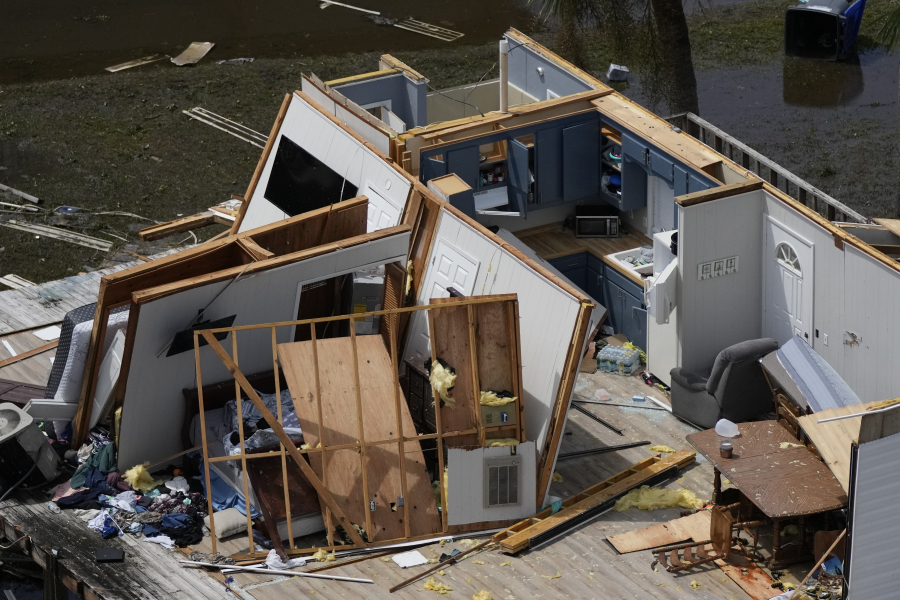HORSESHOE BEACH, Fla. (AP) — Tropical Storm Idalia headed out to sea Thursday after thrashing parts of Florida and Georgia with punishing rains and destructive winds, leaving residents to begin the arduous process of clearing fallen trees, restoring electricity and picking through the debris of devastated homes.
Thus far, authorities have confirmed one death, that of a man hit by a falling tree in Georgia. As many as a half-million customers were without power at one point in Florida and Georgia as the storm ripped down utility poles.
After pounding Florida, Idalia swung east, flooding many of South Carolina’s beaches and leaving some in the state and North Carolina without power before heading back into the Atlantic Ocean. Forecasters said the weakened storm should continue heading away from the U.S. for several days, although officials in Bermuda warned that Idalia could hit the island early next week as a tropical storm.
Rescue and repair efforts were in full force in Florida’s remote Big Bend area, where Idalia roared ashore with 125 mph (201 kph) winds Wednesday, shredding homes, ripping off roofs, snapping tall trees, and turning streets into rivers.
At Horseshoe Beach in central Big Bend, Jewell Baggett picked through the wreckage and debris of her mother’s destroyed home, finding a few pictures and some pots and pans. Fortunately, her mother had evacuated before the storm hit.
Baggett said her grandfather built the home decades ago and it had survived four previous storms.
“And now it’s gone,” she said, along with at least five to six other homes in the area. “Nothing left. A few little trinkets here and there.”
Florida Gov. Ron DeSantis said he planned to tour the area with federal emergency officials on Thursday. He noted that because the storm came ashore in the remote region where Florida’s Panhandle curves into the peninsula, Idalia was far less destructive than feared, providing only glancing blows to Tampa Bay and other more populated areas. In contrast, Hurricane Ian last year hit the heavily populated Fort Myers area, leaving 149 dead in the state.
“I think this one, there was definitely a lot of destruction but it was so much debris and so much woods and that’s just going to require a lot to clean all that up,” DeSantis said.
No hurricane-related deaths were officially confirmed in Florida, but the state’s highway patrol reported two people killed in separate weather-related crashes just hours before Idalia made landfall. A man in Valdosta, Georgia, about 80 miles (130 kilometers) inland, died when a tree fell on him as he tried to clear another tree out of the road, Lowndes County Sheriff Ashley Paulk said.
The storm was still a menace, with 90 mph (145 kph) winds, when it made a direct hit on Valdosta, Georgia Gov. Brian Kemp said.
“We’re fortunate this storm was a narrow one, and it was fast moving and didn’t sit on us,” Kemp told a news conference Thursday in Atlanta. “But if you were in the path, it was devastating. And we’re responding that way.”
Valdosta resident Desmond Roberson said many roads remained blocked by trees and downed powerlines on Thursday and traffic lights were still blacked out at major intersections in the city of 55,000. He said the few gas stations that were open had long lines.
“It’s a maze. … I had to turn around three times, just because roads were blocked off,” Roberson said.
Nearly all of the 600 tarps that officials had set aside to cover damaged roofs had been claimed by Thursday morning, said Meghan Barwick, spokeswoman for surrounding Lowndes County.
More than 24,000 homes and businesses in the county of about 120,000 people remained without electricity, according to Barwick, who said residents should be prepared for several days more without lights or air conditioning.
Chris Exum, a farmer in the south Georgia town of Quitman, estimates that he lost half or more of his pecan crop from Idalia, which he said left “a wall of green” with downed trees and limbs.
Some of the trees are 40 to 50 years old, he noted. “It takes a long time to get back to that point.”
In South Carolina, the storm coupled with already really high tides to send seawater flowing over sand dunes in nearly every beach town, although in most places the water was only about ankle deep. In Charleston, Idalia’s surge topped part of the seawall that protects the downtown, sending ocean water into the streets and neighborhoods where horse-drawn carriages pass million-dollar homes and the famous open-air market.
Preliminary data showed the Wednesday evening high tide reached just over 9.2 feet (2.8 meters), more than 3 feet (0.9 meters) above normal and the fifth-highest reading in Charleston Harbor since records were first kept in 1899.
Bands from Idalia also brought short-lived tornadoes. One flipped a car in suburban Goose Creek, South Carolina, causing minor injuries, authorities said. No major damage was reported.



